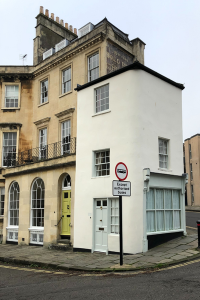|
As a residential property solicitor in Bath and Bradford on Avon, many of my clients are buying or selling listed buildings. Clearly, as the owner or intended purchaser of a listed building, it’s crucial to understand the full extent of your responsibilities. That responsibility extends to maintenance, repairs and other works to the building. But it also includes related structures (eg outbuildings) and even the garden. Indeed, it’s sobering to remember that carrying out unauthorised works to a listed building:
is a criminal offence carrying a maximum penalty of two years imprisonment and an unlimited fine.
What follows is in no way a definitive guide to this complex area. Instead, I hope the information provides a good general introduction to the requirement for listed building consent and the importance of adhering precisely to its terms.
“I can not recommend Victoria more highly. Right from the start, we felt in safe hands. She is knowledgeable, responsive, supportive, thorough, kind, and always completely on top of the situation. In short, she combines professionalism with a real human touch.” D.N. (client)
What is a listed building?
 A listed building is one placed on a statutory list to mark its special historic, architectural, or cultural interest. Each of the four devolved administrations maintains a separate list. In England, Historic England administers the list.
A listed building is one placed on a statutory list to mark its special historic, architectural, or cultural interest. Each of the four devolved administrations maintains a separate list. In England, Historic England administers the list.
There are three grades of listed buildings. Grade II listed buildings are of special interest. Grade II* listed buildings are ones considered of national importance of more than special interest. Finally, Grade I listed buildings are ones regarded as of exceptional interest.
Currently, over 90% of all listed buildings are Grade II.
Although age is not the only consideration (indeed, the newest listed building is of 1998 vintage), generally, listed buildings are likely to be older. Buildings largely in their original condition and built before 1700 are invariably listed. And the vast majority of those built between 1700 and 1850, likewise.
Listed building restrictions
Whatever grade the building, its listed status means greater than usual control over what if any changes are permissible. And that applies to both the building’s interior and exterior. In most cases, this extends to any objects, structures and buildings attached to the listed building or falling within its curtilage. The common definition of curtilage is an area of land attached to a building and forming one enclosure with it – typically a garden, courtyard, or outbuilding.
This stricter control applies to proposed new structures as well as existing ones. For example, erecting a garden room typically falls within the scope of permitted development, but not within the curtilage of a listed building.
“Victoria was strongly recommended to me, and I can honestly say she is the best solicitor I have ever used. Professional but very approachable and kind.” C.P. (client)
Listed building consent
 For most types of work affecting the “special architectural or historic interest” of a listed building, the owner must apply for listed building consent from the planning department at their local authority. This is in addition to the usual requirements for planning permission and building regulation consent.
For most types of work affecting the “special architectural or historic interest” of a listed building, the owner must apply for listed building consent from the planning department at their local authority. This is in addition to the usual requirements for planning permission and building regulation consent.
When considering any work at all to a listed building, first contact the planning department. An informal discussion should reveal what they may or may not allow. Many local authorities employ a conservation officer who can offer more specialist advice on older buildings, including listed buildings. Finding out what might be acceptable, following their advice, and being prepared to compromise and adapt your ideas will make a successful application more likely. It may also save you considerable time and money.
In formulating your ideas, remember that the planning department’s focus is preserving the building, its setting and the features that make it of special interest. More advice on applying for listed building consent is available on the government’s Planning Portal.
Check out Victoria’s Listed Building Consent Checklist |
Failing to obtain or adhere to listed building consent
Carrying out work to a listed building without consent or in breach of the conditions of consent is a serious matter. The planning department will almost certainly serve a listed building enforcement notice, irrespective of any criminal sanction. A listed building enforcement notice enables a local authority:
- to require the remediation of the works to bring the building back to its former condition; or, if that is not practical,
- to alleviate the work’s detrimental effect.
Understandably, either can prove extremely expensive.
Remember, there is no time restriction on a listed building enforcement notice. The local authority serves the notice on the current owner, even if the default predates their ownership. So, when buying a listed building, your conveyancing solicitor must check carefully whether any past works comply fully with the required consent.
A recent example I encountered involved a client buying a Grade I listed townhouse. Many years ago, the property underwent extensive refurbishment. Although the then owner obtained listed building consent, the works carried out were not in complete accordance with the plans attached to the consent. The major breaches involved the kitchen and bathroom. Both rooms were in different places than those indicated on the plans. Before proceeding, we requested that the seller either apply for retrospective listed building consent or regularisation of works. Not doing so would mean our client inheriting the associated liability.
Also by Victoria: Grade II listed building restrictions: a guide |

 Residential property specialist
Residential property specialist